Effects of Eutectic Modification and Grain Refinement on Microstructure and Properties of PM AlSi7 Metallic Foams
Abstract
:1. Introduction
1.1. Foam Fundamentals
- (a)
- global density
- (b)
- foam structure
- (c)
- matrix alloy
- (d)
- foam microstructure
1.2. Grain Refinement and Modification of Al-Si Alloys
2. Materials and Methods
2.1. Materials and Sample Production
2.2. Microstructural Characterization
2.3. Pore Structure and Morphology
2.4. Foam Expansion Measurements
2.5. Mechanical Testing and Evaluation of Test Results
3. Results
3.1. Microstructural Modification of Powder Compacts
3.2. Expansion Characteristics and Pore Structure of Precursor Material Variants
3.3. Microstructural Modification of Foams and Influence on Mechanical Properties
4. Discussion
5. Conclusions
Author Contributions
Funding
Acknowledgments
Conflicts of Interest
References
- Baumeister, J.; Rausch, G.; Stöbener, K.; Lehmhus, D.; Busse, M. Aluminium foam composites–applications in railroad manufacturing. Mater. Werkst. 2007, 38, 939–942. [Google Scholar] [CrossRef]
- Banhart, J.; Seeliger, H.-W. Aluminium Foam Sandwich Panels: Manufacture, Metallurgy and Applications. Adv. Eng. Mater. 2008, 10, 793–802. [Google Scholar] [CrossRef]
- Neugebauer, R.; Hipke, H. Machine tools with metal foams. Adv. Eng. Mater. 2006, 8, 858–863. [Google Scholar] [CrossRef]
- Garcia-Moreno, F. Commercial Applications of Metal Foams: Their Properties and Production. Materials 2016, 9, 85. [Google Scholar] [CrossRef]
- Baumeister, J. Verfahren Zur Herstellung Poröser Metallkörper. German Patent No. DE 40 18 360 C1, 8 June 1991. (date of filing, patent granted 29 May 1991). [Google Scholar]
- Banhart, J. Manufacture, characterization and application of cellular metals and metal foams. Prog. Mater. Sci. 2001, 46, 559–632. [Google Scholar] [CrossRef]
- Lehmhus, D.; Vesenjak, M.; de Schampheleire, S.; Fiedler, T. From Stochastic Foam to Designed Structure: Balancing Cost and Performance of Cellular Metals. Materials 2017, 10, 922. [Google Scholar] [CrossRef]
- Martin, U.; Mosler, U.; Lehmhus, D.; Müller, A.; Heinzel, G. Hierarchical structure of aluminium alloys and relation to compression behavior. High Temp. Mater. Process. 2007, 26, 291–296. [Google Scholar] [CrossRef]
- Mosler, U.; Martin, U.; Losseva, N.; Oettel, H. A statistic approach to estimate the compression strength of aluminium foams. In Cellular Metal: Manufacture, Properties, Applications; Banhart, J., Fleck, N.A., Mortensen, A., Eds.; MIT Publishing: Bremen, Germany, 2003; pp. 387–392. [Google Scholar]
- Mu, Y.; Yao, C.; Liang, L.; Luo, H.; Zu, G. Deformation mechanisms in closed-cell aluminum foam in compression. Scr. Mater. 2010, 63, 629–632. [Google Scholar] [CrossRef]
- Avalle, M.; Lehmhus, D.; Peroni, L.; Pleteit, H.; Schmiechen, P.; Belingardi, G.; Busse, M. AlSi7 metallic foams-aspects of material modelling for crash analysis. Int. J. Crashworth. 2009, 14, 269–285. [Google Scholar] [CrossRef]
- Gibson, L.J.; Ashby, M.F. Cellular Solids; Cambridge University Press: Cambridge, UK, 1997. [Google Scholar]
- Kennedy, A.R.; Lopez, V.H. The decomposition behaviour of as-received and oxidized TiH2 foaming-agent powder. Mater. Sci. Eng. A 2003, 357, 258–263. [Google Scholar] [CrossRef]
- Lehmhus, D.; Rausch, G. Tailoring titanium hydride decomposition kinetics by annealing in various atmospheres. Adv. Eng. Mater. 2004, 6, 313–330. [Google Scholar] [CrossRef]
- Lehmhus, D. Dynamic Collapse Mechanisms in Metal Foam Formation. Adv. Eng. Mater. 2010, 12, 465–471. [Google Scholar] [CrossRef]
- Matijasevic, B.; Banhart, J. Improvement of aluminium foam technology by tailoring of blowing agent. Scr. Mater. 2006, 54, 503–508. [Google Scholar] [CrossRef]
- Matijasevic-Lux, B.; Banhart, J.; Fiechter, S.; Görke, O.; Wanderka, N. Modification of titanium hydride for improved aluminium foam manufacture. Acta Mater. 2006, 54, 1887–1900. [Google Scholar] [CrossRef]
- Proa-Flores, P.M.; Drew, R.A.L. Production of Aluminum Foams with Ni-coated TiH2 Powder. Adv. Eng. Mater. 2008, 10, 830–835. [Google Scholar] [CrossRef]
- Stanzick, H.; Wichmann, M.; Weise, J.; Helfen, L.; Baumbach, T.; Banhart, J. Process control in aluminium foam production using real-time X-ray radioscopy. Adv. Eng. Mater. 2002, 4, 814–823. [Google Scholar] [CrossRef]
- Mosler, U.; Heinzel, G.; Martin, U.; Oettel, H. Microstructure and deformation behaviour of aluminium foams. Mater. Werkst. 2000, 31, 519–522. [Google Scholar] [CrossRef]
- Gall, K.; Yang, N.; Horstemeyer, M.; McDowell, D.L.; Fan, J. The debonding and fracture of Si particles during the fatigue of a cast Al-Si alloy. Metall. Mater. Trans. A 1999, 30, 3079–3088. [Google Scholar] [CrossRef]
- Su, J.F.; Nie, X.; Stoilov, V. Characterization of fracture and debonding of Si particles in AlSi alloys. Mater. Sci. Eng. A 2010, 527, 7168–7175. [Google Scholar] [CrossRef]
- Su, J.F. Characterization of Fracture and Debonding of Silicon Particles in Aluminium Silicon Alloys. Master Thesis, University of Windsor, Windsor, ON, Canada, 2009. [Google Scholar]
- Lados, D.A.; Apelian, D. Relationships between microstructure and fatigue crack propagation paths in Al–Si–Mg cast alloys. Eng. Fract. Mech. 2008, 75, 821–832. [Google Scholar] [CrossRef]
- Chan, K.S.; Jones, P.; Wang, Q. Fatigue crack growth and fracture paths in sand cast B319 and A356 aluminum alloys. Mater. Sci. Eng. A 2003, 341, 18–34. [Google Scholar] [CrossRef]
- Xia, S.; Qi, Y.; Perry, T.; Kim, K.-S. Strength Characterization of Al/Si interfaces: A hybrid method of nanoindentation and finite element analysis. Acta Mater. 2009, 57, 695–707. [Google Scholar] [CrossRef]
- Banhart, J.; Seeliger, H.-W. Recent Trends in Aluminum Foam Sandwich Technology. Adv. Eng. Mater. 2012, 14, 1082–1087. [Google Scholar] [CrossRef]
- Stöbener, K.; Lehmhus, D.; Avalle, M.; Peroni, L.; Busse, M. Aluminum foam-polymer hybrid structures (APM aluminum foam) in compression testing. Int. J. Solids Struct. 2008, 45, 5627–5641. [Google Scholar] [CrossRef]
- Lehmhus, D.; Baumeister, J.; Stutz, L.; Schneider, E.; Stöbener, K.; Avalle, M.; Peroni, L.; Peroni, M. Mechanical characterisation of particulate aluminium foams-strain-rate, density and matrix alloy vs. adhesive effects. Adv. Eng. Mater. 2010, 12, 596–603. [Google Scholar] [CrossRef]
- Vesenjak, M.; Gacnik, F.; Krstulovic-Opara, L.; Ren, Z. Behavior of composite advanced pore morphology foam. J. Compos. Mater. 2011, 45, 2823–2831. [Google Scholar] [CrossRef]
- Duarte, I.; Vesenjak, M.; Krstulović-Opara, L.; Ren, Z. Compressive performance evaluation of APM (Advanced Pore Morphology) foam filled tubes. Compos. Struct. 2015, 134, 409–420. [Google Scholar] [CrossRef]
- Lehmhus, D.; Banhart, J.; Rodriguez-Perez, M.A. Adaptation of aluminium foam properties by means of precipitation hardening. Mater. Sci. Technol. 2002, 18, 474–479. [Google Scholar] [CrossRef]
- Lázaro, J.; Solórzano, E.; Escudero, J.; de Saja, J.A.; Rodríguez-Pérez, M.A. Applicability of Solid Solution Heat Treatments to Aluminum Foams. Metals 2012, 2, 508–528. [Google Scholar] [CrossRef]
- Khan, K.L.A.; Kumar, G.; Prasad, R. Effect of Age Hardening and Quenching Media on Aluminium Foams. Int. J. Appl. Eng. Res. 2018, 13, 245–248. [Google Scholar]
- Duarte, I.; Banhart, J. A study of aluminium foam formation–kinetics and microstructure. Acta Mater. 2000, 48, 2349–2362. [Google Scholar] [CrossRef]
- Lehmhus, D.; Busse, M. Potential new matrix alloys for production of PM aluminium foams. Adv. Eng. Mater. 2004, 6, 391–396. [Google Scholar] [CrossRef]
- Campana, F.; Pilone, D. Effect of wall microstructure and morphometric parameters on the crush behaviour of Al alloy foams. Mater. Sci. Eng. A 2008, 479, 58–64. [Google Scholar] [CrossRef]
- Helwig, H.-M.; Garcia-Moreno, F.; Banhart, J. A study of Mg and Cu additions on the foaming behaviour of Al–Si alloys. J. Mater. Sci. 2011, 46, 5227–5236. [Google Scholar] [CrossRef]
- Kennedy, A.R.; Asavavisichai, S. Effect of TiB2 particle addition on the expansion, structure and mechanical properties of PM Al foams. Scr. Mater. 2004, 50, 115–119. [Google Scholar] [CrossRef]
- Nafisi, S.; Ghomashchi, R. Grain refining of conventional and semi-solid A356 Al–Si alloy. J. Mater. Process. Technol. 2006, 174, 371–383. [Google Scholar] [CrossRef]
- Helwig, H.-M.; Hiller, S.; Garcia-Moreno, F.; Banhart, J. Influence of Compaction Conditions on the Foamability of AlSi8Mg4 Alloy. Metall. Mater. Trans. B 2009, 40, 755–767. [Google Scholar] [CrossRef]
- Banhart, J.; Garcia-Moreno, F.; Heim, K.; Seeliger, H.-W. Light-weighting in transportation and defence using aluminium foam sandwich structures. In Proceedings of the International Symposium on Light Weighting for Defence, Aerospace and Transportation, Indian Institute of Metals, Goa, India, 11 November 2017. [Google Scholar]
- Easton, M.; St. John, D. Grain Refinement of Aluminium Alloys: Part, I. The Nucleant and Solute Paradigms–A Review of the Literature. Metall. Mater. Trans. A 1999, 30, 1613–1623. [Google Scholar] [CrossRef]
- Easton, M.; St. John, D. Grain Refinement of Aluminium Alloys: Part II. Confirmation of, and a Mechanism for, the Solute Paradigm. Metall. Mater. Trans. A 1999, 30, 1625–1633. [Google Scholar] [CrossRef]
- Schumacher, P. Keimbildungsmechanismen während der Kornfeinung von Al-Si-Legierungen. Giess. Rundsch. 2003, 50, 228–230. [Google Scholar]
- Müller, K. Möglichkeiten der Gefügebeeinflussung Eutektischer und Naheutektischer Aluminium-Silizium-Gusslegierungen unter Berücksichtigung der Mechanischen Eigenschaften; Fortschrittsberichte VDI, Series 5; VDI Verlag GmbH: Düsseldorf, Germany, 1996. [Google Scholar]
- Chen, X.-G. Kristallisation des Aluminium-Silizium-Eutektikums und Anwendung der Thermischen Analyse zur Kontrolle der Veredelung. Ph.D. Thesis, RWTH Aachen, Aachen, Germany, 1990. [Google Scholar]
- Chen, X.-G.; Ellerbrok, R.; Engler, S. Über die eutektischen Körner von Aluminium-Silizium-Legierungen. Teil 1. Veredeltes Eutektikum. Giessereiforschung 1990, 42, 1–10. [Google Scholar]
- Qiyang, L.; Qingchun, L.; Qifu, L. Modification of Al-Si alloys with Sodium. Acta Metall. Mater. 1991, 39, 2497–2502. [Google Scholar] [CrossRef]
- Srirangam, P.; Kramer, M.J.; Shankar, S. Effect of strontium on liquid structure of AlSi hypoeutectic alloys using high-energy X-ray diffraction. Acta Mater. 2011, 60, 503–513. [Google Scholar] [CrossRef]
- Timpel, M.; Wanderka, N.; Schlesiger, R.; Yamamoto, T.; Lazarev, N.; Isheim, D.; Schmitz, G.; Matsumura, S.; Banhart, J. The role of Strontium in modifying lauminium-silicon alloys. Acta Mater. 2012, 60, 3920–3928. [Google Scholar] [CrossRef]
- Dahle, A.K.; Tondel, P.A.; Paradies, C.J.; Arnberg, L. Effect of Grain Refinement on the Fluidity of Two Commercial AI-Si Foundry Alloys. Metall. Mater. Trans. A 1996, 27, 2305–2313. [Google Scholar] [CrossRef]
- Yan, M.; Luo, W. Effects of grain refinement on the rheological behaviors of semisolid hypoeutectic Al–Si alloys. Mater. Chem. Phys. 2007, 104, 267–270. [Google Scholar] [CrossRef]
- Song, X.; Bian, X.; Zhang, J.; Zhang, J. Temperature-dependent viscosities of eutectic Al–Si alloys modified with Sr and P. J. Alloys Compd. 2009, 479, 670–673. [Google Scholar] [CrossRef]
- Banhart, J. Metal Foams: Production and Stability. Adv. Eng. Mater. 2006, 8, 781–794. [Google Scholar] [CrossRef]
- Haibel, A.; Rack, A.; Banhart, J. Why are metal foams stable? Appl. Phys. Lett. 2001, 78, 154102. [Google Scholar] [CrossRef] [Green Version]
- Chen, Z.; Kang, H.; Fan, G.; Li, J.; Lu, Y.; Jie, J.; Zhang, Y.; Li, T.; Jian, X.; Wang, T. Grain refinement of hypoeutectic Al-Si alloys with B. Acta Mater. 2016, 120, 168–178. [Google Scholar] [CrossRef]
- Easton, M.; Qian, M.; Prasad, A.; St. John, D. Recent advances in grain refinement of light metals and alloys. Curr. Opin. Solid State Mater. Sci. 2016, 20, 13–24. [Google Scholar] [CrossRef] [Green Version]
- Lee, C. Effect of Ti-B addition on the variation of microporosity and tensile properties of A356 aluminium alloys. Mater. Sci. Eng. A 2016, 668, 152–159. [Google Scholar] [CrossRef]
- Liu, Z. Review of Grain Refinement of Cast Metals Through Inoculation: Theories and Developments. Metall. Mater. Trans. A 2017, 48, 4755–4776. [Google Scholar] [CrossRef]
- Müller, A.; Mosler, U. Gefügeinterpretation von Aluminiumschäumen. In Sonderbände der Praktischen Metallographie; Petzow, G., Ed.; Werkstoff-Informationsgesellschaft mbH: Frankfurt, Germany, 2001; Volume 32, p. 279. [Google Scholar]
- Mosler, U.; Heinzel, G.; Martin, U.; Oettel, H. Quantitative Charakterisierung der zellularen Struktur von Aluminium-Schäumen. In Sonderbände der Praktischen Metallographie; Petzow, G., Ed.; Werkstoff-Informationsgesellschaft mbH: Frankfurt, Germany, 2001; Volume 32, p. 121. [Google Scholar]
- Schumann, H. Metallographie; Wiley-VCH Verlag: Weinheim, Germany, 2004. [Google Scholar]
- Ohser, J.; Lorz, U. Quantitative Gefügeanalyse: Theoretische Grundlagen und Anwendung. In Freiberger Forschungshefte, B 276: Metallurgie und Werkstofftechnik, Werkstoffeinsatz; Deutscher Verlag für Grundstoffindustrie: Leipzig, Germany, 1994. [Google Scholar]
- Weber, M. Herstellung von Metallschäumen und Beschreibung der Werkstoffeigenschaften. Ph.D. Thesis, Technical University of Clausthal, Clausthal, Germany, 1995. [Google Scholar]
- Andrews, E.W.; Gioux, G.; Onck, P.; Gibson, L.J. Size effects in ductile cellular solids. Part II: Experimental results. Int. J. Mech. Sci. 2001, 43, 701–713. [Google Scholar] [CrossRef] [Green Version]
- Yu, H.; Guo, Z.; Li, B.; Yao, G.; Luo, H.; Liu, Y. Research into the effect of cell diameter of aluminium foam on its compressive properties. Mater. Sci. Eng. A 2007, 454, 542–546. [Google Scholar] [CrossRef]
- Alkheder, M.; Vural, M. Mechanical response of cellular solids: Role of cellular topology and microstructural irregularity. Int. J. Eng. Sci. 2008, 46, 1035–1051. [Google Scholar] [CrossRef]
- Weibull, W. A statistical distribution function of wide applicability. J. Appl. Mech. 1951, 18, 293–297. [Google Scholar]
- Chen, X.; Geng, H.; Li, Y. Study on the Eutectic Modification Level of Al-7Si Alloy by Computer Aided Recognition of Thermal Analysis Cooling Curves. Mater. Sci. Eng. A 2006, 419, 283–289. [Google Scholar] [CrossRef]
- Sahm, P.R.; Egry, I.; Volkmann, T. Schmelze, Erstarrung, Grenzflächen–Eine Einführung in die Physik und Technologie Flüssiger und Fester Metalle; Viehweg-Verlag: Wiesbaden, Germany, 2003. [Google Scholar]
- Weigand, P. Untersuchung der Einflussfaktoren auf die Pulvermetallurgische Herstellung von Aluminiumschaum. Ph.D. Thesis, RWTH Aachen, Aachen, Germany, 1999. [Google Scholar]
- Asavavisichai, S.; Kennedy, A.R. The role of oxidation during compaction on the expansion and stability of Al foams made via a PM Route. Adv. Eng. Mater. 2006, 8, 568–572. [Google Scholar] [CrossRef]
- Körner, C.; Arnold, M.; Singer, R.F. Metal foam stabilization by oxide network particles. Mater. Sci. Eng. A 2005, 396, 28–40. [Google Scholar] [CrossRef]
- Nadella, R.; Sahu, S.N.; Gokhale, A.A. Foaming characteristics of Al-Si-Mg (LM25) alloy prepared by liquid metal processing. Mater. Sci. Technol. 2010, 26, 908–913. [Google Scholar] [CrossRef]
- Tekoglu, C.; Gibson, L.J.; Pardoen, T.; Onck, P.R. Size effects in foams: Experiments and modelling. Prog. Mater. Sci. 2011, 56, 109–138. [Google Scholar] [CrossRef]
- Lehmhus, D.; Busse, M. Mechanical performance of structurally optimized AlSi7 aluminum foams—An experimental study. Mater. Werkst. 2014, 45, 1061–1071. [Google Scholar] [CrossRef]
- Asavavisichai, S.; Kennedy, A.R. The effect of oxides in various aluminium powders on foamability. Procedia Eng. 2012, 32, 714–721. [Google Scholar] [CrossRef] [Green Version]
- Blazy, J.-S.; Marie-Louise, A.; Forest, S.; Chastel, Y.; Pineau, A.; Awade, A.; Grolleron, C.; Moussy, F. Deformation and fracture of aluminium foams under proportional and non-proportional multi-axial loading: Statistical analysis and size effect. Int. J. Mech. Sci. 2004, 46, 217–244. [Google Scholar] [CrossRef]
- Xu, C.; Ma, C.; Sun, Y.; Hanada, S.; Lu, G.; Guan, S. Optimizing strength and ductility of Al-7Si-0.4 Mg foundry alloy: Role of Cu and Sc addition. J. Alloys Compd. 2019, 810, 151944. [Google Scholar]
- Riestra, M.; Ghassemali, E.; Bogdanoff, T.; Seifeddine, S. Interactive effects of grain refinement, eutectic modification and solidification rate on tensile properties of Al-10Si alloy. Mater. Sci. Eng. A 2017, 703, 270–279. [Google Scholar] [CrossRef]



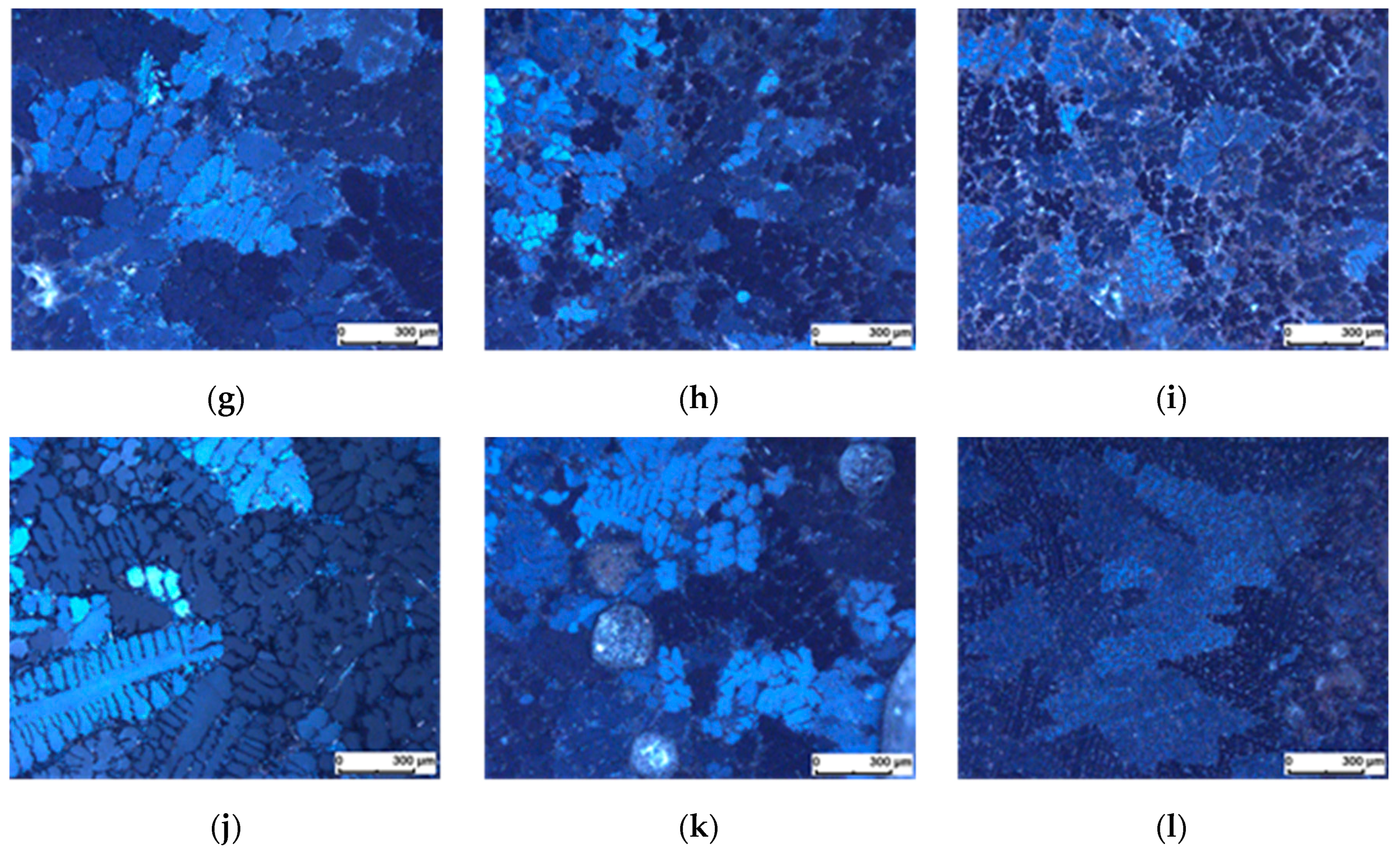




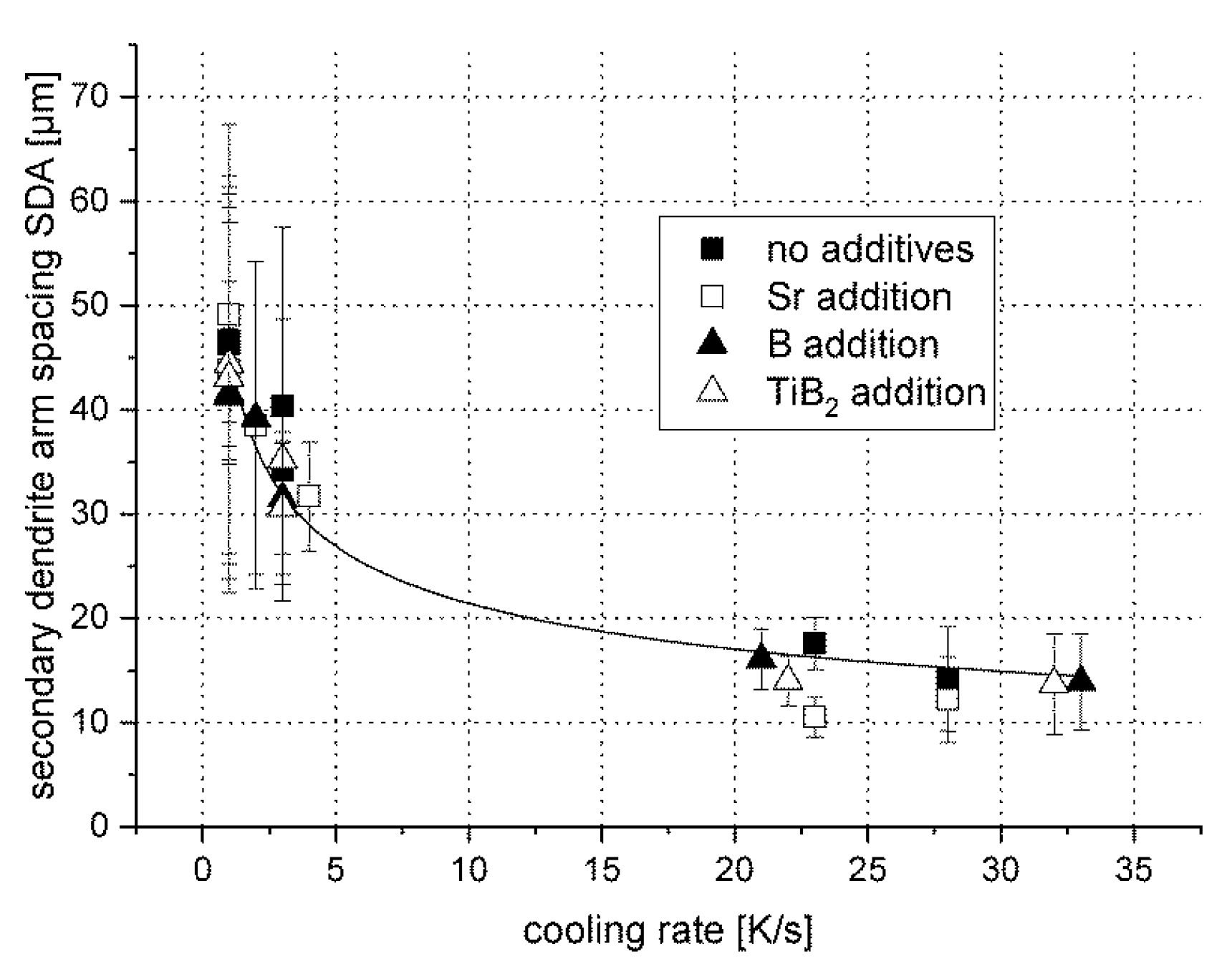



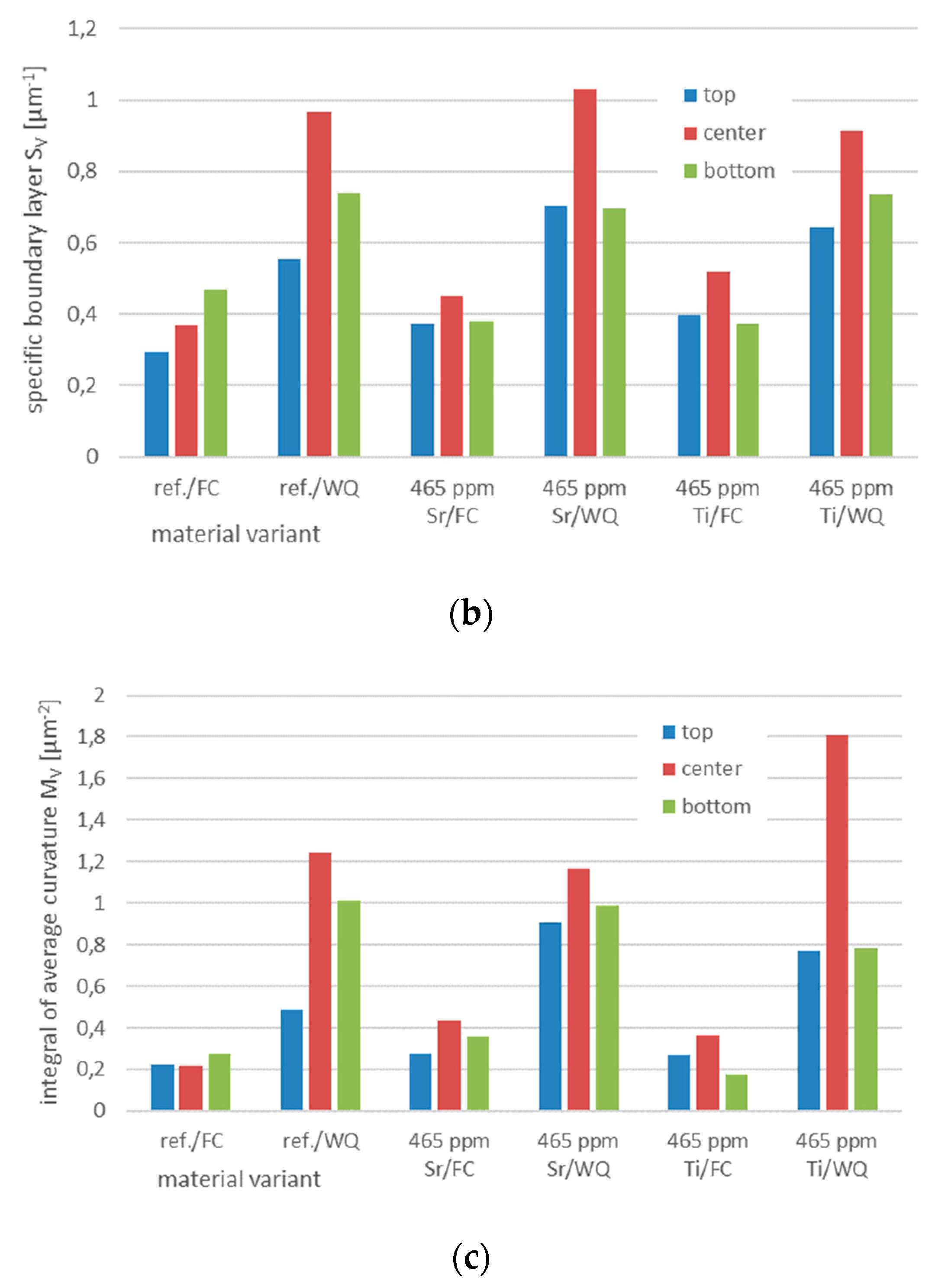
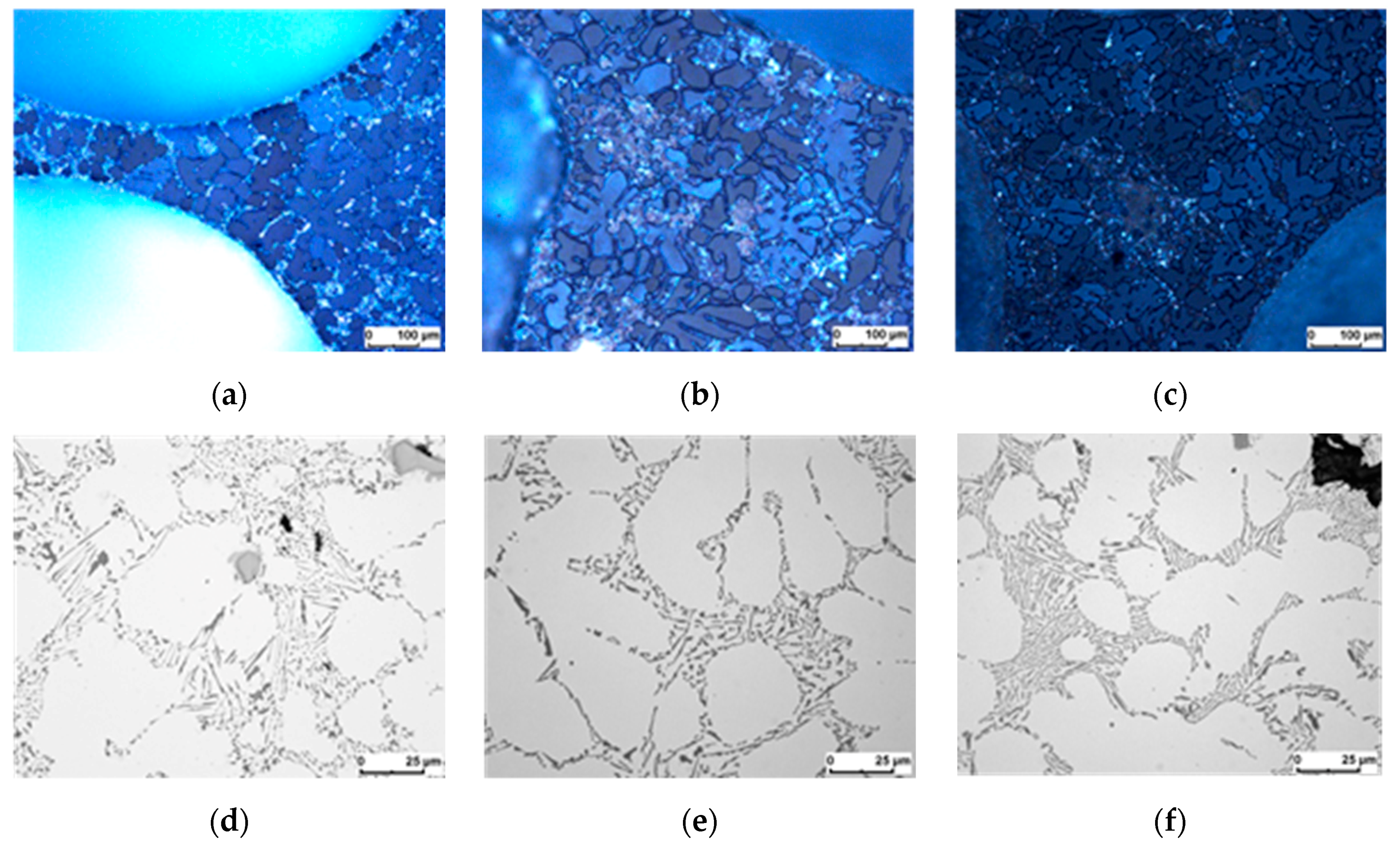








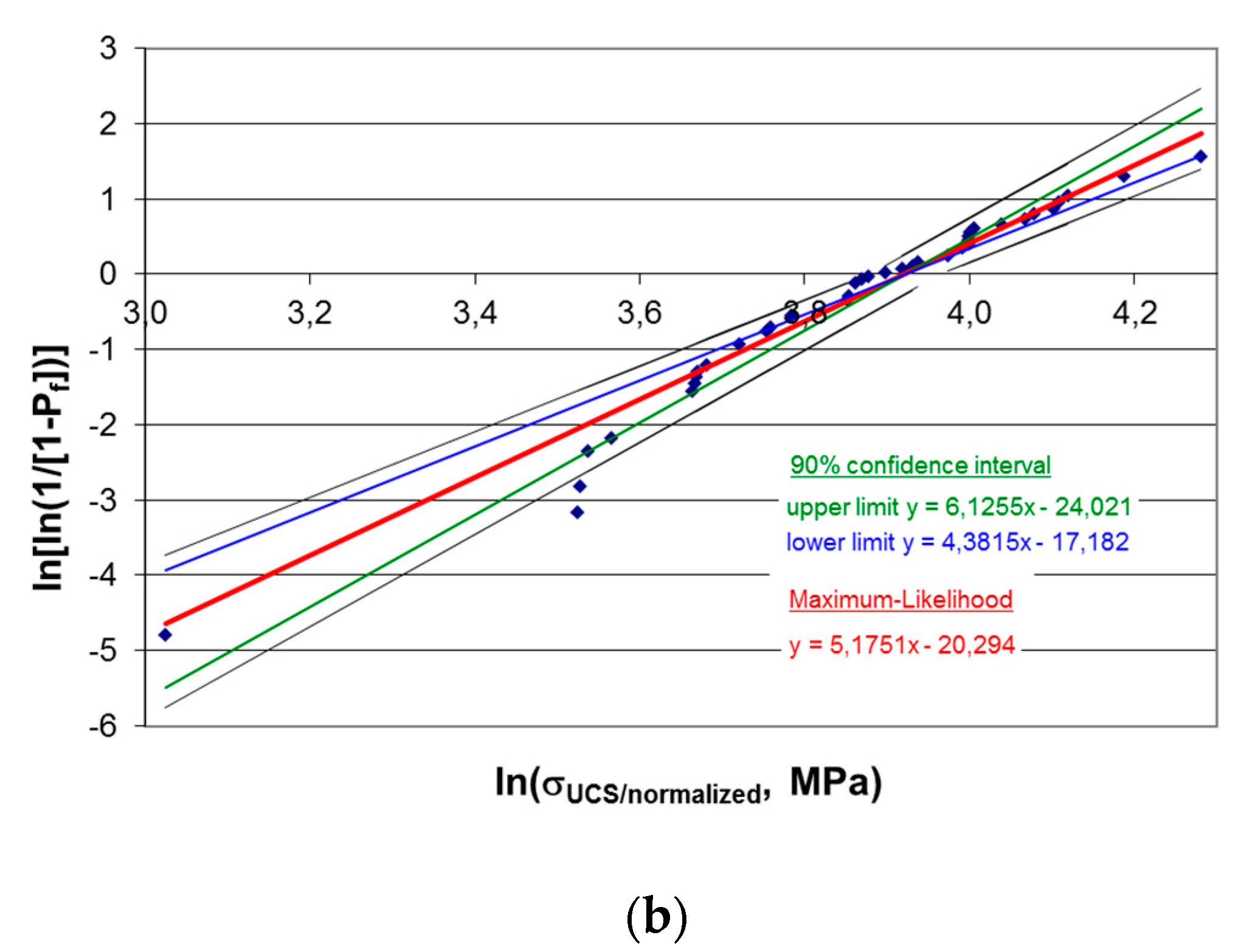
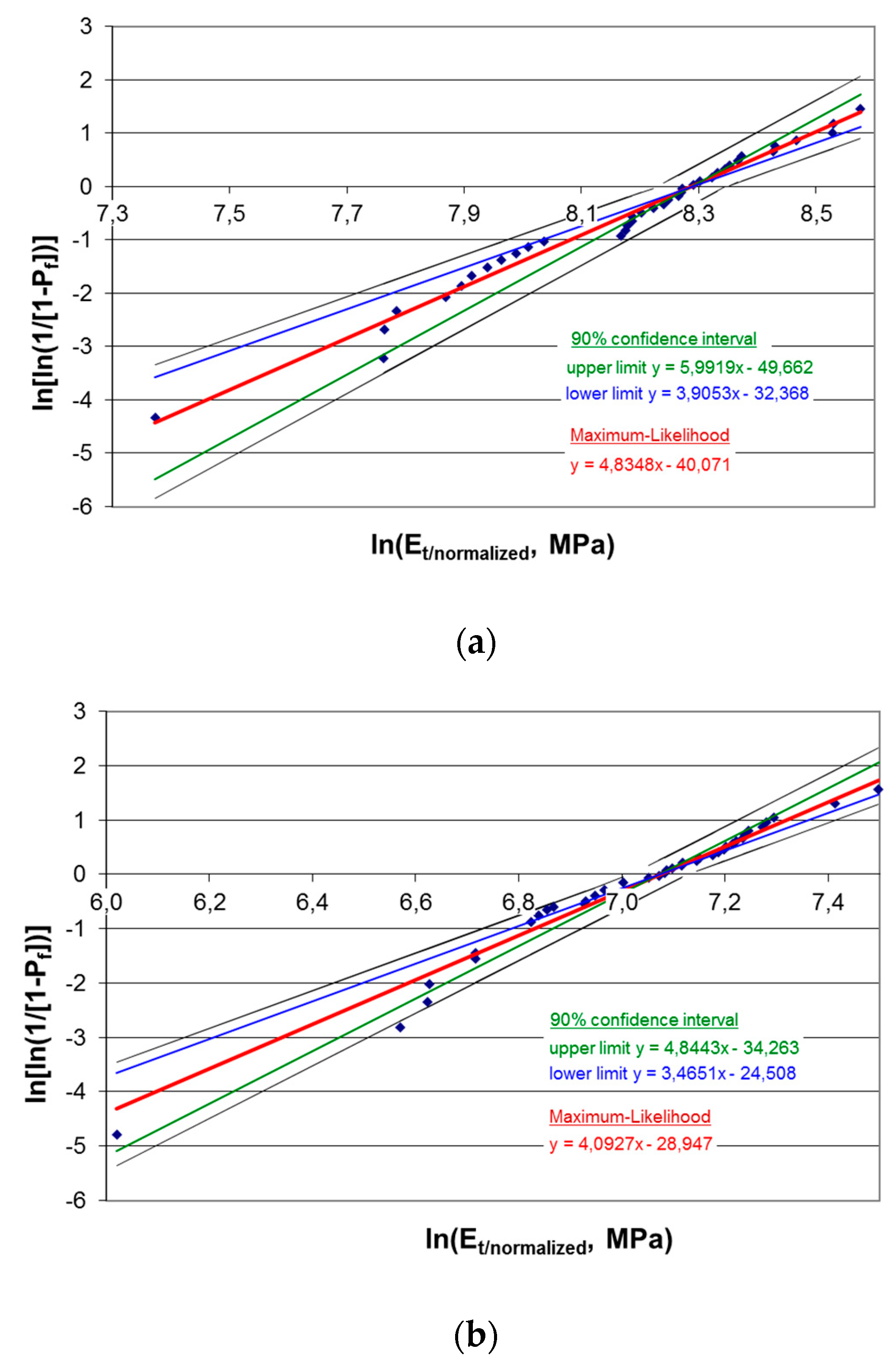
| Powder | Supplier Information | Measurement | ||||||
|---|---|---|---|---|---|---|---|---|
| Name | Production Method | Purity [wt.%] | Particle Size [µm] | Modifying Agent (MA) | MA Content [wt.%] | Particle Size, Dmean [µm] | Particle Size, D50 [µm] | |
| Al-1 | Ecka 1 grade AS71 | air atomized | 99.7 | <160 | - | - | 77.38 | 70.08 |
| Al-2 | Alpoco | inert gas atomized | 99.7 | <150 | - | - | 39.40 | 25.41 |
| Al/Sr | Alpoco | inert gas atomized | n. a. 2 | <150 | Sr | 0.05 | 39.61 | 28.00 |
| Al/B | Alpoco | inert gas atomized | n. a. 2 | <150 | B | 0.007 | 57.30 | 41.63 |
| Al/TiB2 | Alpoco | inert gas atomized | n. a. 2 | <150 | Ti/TiB2 | 0.05 Ti, as 5/1 TiBAl | 42.11 | 29.71 |
| Si | Ölschläger | milled | 98.5 | 60–100 | n.a. | n.a. | 25.71 | 20.25 |
| TiH2 | Chemetall grade N | milled | 99 | < 63 | n.a. | n.a. | 18.14 | 16.04 |
| Sample Series | 1 | 2 | |||||
|---|---|---|---|---|---|---|---|
| Holding temperature | [°C] | 660 | 680 | ||||
| Holding time | [min.] | 5 | 10 | ||||
| Cooling method | water quenching (WQ) | forced convection (FC) | natural convection (NC) | water quenching (WQ) | forced convection (FC) | natural convection (NC) | |
| Reference AlSi7 | n.a. | ||||||
| B grain refined | [wt%] | 0.007 | - | - | - | - | - |
| 0.014 | 0.014 | 0.014 | 0.014 | 0.014 | 0.014 | ||
| 0.028 | - | - | - | - | - | ||
| TiB2 grain refined 1 | [wt%] | 0.026 | - | - | - | - | - |
| 0.035 | 0.035 | 0.035 | 0.035 | 0.035 | 0.035 | ||
| 0.0465 | - | - | - | - | - | ||
| Sr modified | [wt%] | 0.013 | - | - | - | - | - |
| 0.025 | 0.025 | 0.025 | 0.025 | 0.025 | 0.025 | ||
| 0.0465 | |||||||
| Sample Series | ||||
|---|---|---|---|---|
| Al-FC | Al/TiB2-FC | Al-TiH2-ht-FC | ||
| Number of compression test samples | [-] | 60 | 38 | 20 |
| Compaction method | hot … | extrusion | axial pressing | axial pressing |
| Al powder | Al-1 | Al-2; Al/TiB2 | Al-1 | |
| Foaming agent | TiH2 as received | TiH2 as received | TiH2, treated 4h@500 °C, air | |
| Ti level (as 5/1 TiBAl) | [ppm] | - | 465 | - |
| min./max. density of compression test samples | [g/cm3] | 0.18/0.78 | 0.17/0.61 | 0.19/0.92 |
| cooling method | forced conv. 1 | forced conv. | forced conv. | |
| Sample Series | Cooling | Cooling Rate Ks−1 at Position Within Foam Sample | ||
|---|---|---|---|---|
| Top | Center | Bottom | ||
| Reference AlSi7 | forced convection | 17.79 | 11.83 | 7.10 |
| water quenching | 47.51 | 82.94 | 69.13 | |
| AlSi7 with 465 ppm Sr | forced convection | 11.21 | 14.40 | 25.05 |
| water quenching | 28.17 | 67.85 | 55.36 | |
| AlSi7 with 465 ppm Ti as TiB2 | forced convection | 19.86 | 15.79 | 9.77 |
| water quenching | 63.03 | 92.04 | 79.50 | |
| Property | Sample Series | ρMatrix−n · Cpl/UCS/Et | n | R2 |
|---|---|---|---|---|
| Plateau Strength (Cpl) 1 | AlSi7/Ref-FC | 11.415 | 1.155 | 0.7179 |
| AlSi7-TiB2-FC | 8.2648 | 0.8882 | 0.6934 | |
| AlSi7-TiH2/ht-FC | 30.45 | 1.977 | 0.9827 | |
| Ultimate Compressive Strength (CUCS) 1 | AlSi7/Ref-FC | 14.672 | 1.197 | 0.7254 |
| AlSi7-TiB2-FC | 12.373 | 1.232 | 0.8389 | |
| AlSi7-TiH2/ht-FC | 29.609 | 1.562 | 0.9882 | |
| Tangent Modulus (CEt) 1 | AlSi7/Ref-FC | 514.73 | 0.7620 | 0.4870 |
| AlSi7-TiB2-FC | 1035.8 | 1.283 | 0.6995 | |
| AlSi7-TiH2/ht-FC | 1198.7 | 1.471 | 0.9621 |
| Property | Weibull Parameter | Reference AlSi7 | Refined AlSi7-TiB2 |
|---|---|---|---|
| Plateau Strength | scale parameter σ0, plateau/normalized | 37.8 | 21.0 |
| shape parameter/ modulus mplateau | 4.06 | 6.19 | |
| Ult. Comp. Strength | σ0, UCS/normalized | 50.5 | 44.0 |
| mUCS | 5.18 | 6.36 | |
| Tangent Modulus | E0, t/normalized | 1179.4 | 3976.2 |
| mEt | 4.09 | 4.83 |
© 2019 by the authors. Licensee MDPI, Basel, Switzerland. This article is an open access article distributed under the terms and conditions of the Creative Commons Attribution (CC BY) license (http://creativecommons.org/licenses/by/4.0/).
Share and Cite
Lehmhus, D.; Hünert, D.; Mosler, U.; Martin, U.; Weise, J. Effects of Eutectic Modification and Grain Refinement on Microstructure and Properties of PM AlSi7 Metallic Foams. Metals 2019, 9, 1241. https://doi.org/10.3390/met9121241
Lehmhus D, Hünert D, Mosler U, Martin U, Weise J. Effects of Eutectic Modification and Grain Refinement on Microstructure and Properties of PM AlSi7 Metallic Foams. Metals. 2019; 9(12):1241. https://doi.org/10.3390/met9121241
Chicago/Turabian StyleLehmhus, Dirk, Daniela Hünert, Ulrike Mosler, Ulrich Martin, and Jörg Weise. 2019. "Effects of Eutectic Modification and Grain Refinement on Microstructure and Properties of PM AlSi7 Metallic Foams" Metals 9, no. 12: 1241. https://doi.org/10.3390/met9121241





